

 |
Search the Site with

|
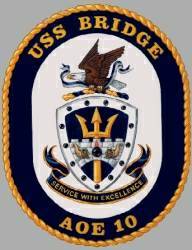 | 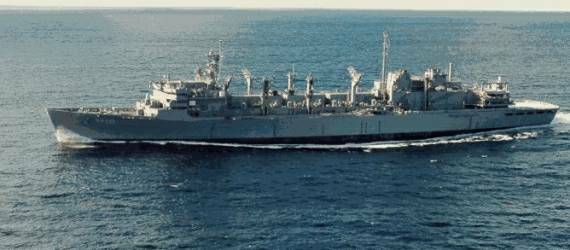 |
USNS BRIDGE was the fourth ship in the SUPPLY - class of Fast Combat Support Ships and the second ship in the Navy named after Commodore Horatio Bridge. On June 24, 2004, the BRIDGE was transfered to the Military Sealift Command. As a US Naval Ship, the BRIDGE did no longer carry the weapons systems she previously (as "USS BRIDGE") was equipped with. One of these systems was the Phalanx CIWS. As a cost-saving measure, the ship was deactivated in September 2014. Since then, the BRIDGE is held in reserve at the Puget Sound Naval Shipyard, Bremerton, Wash.
| General Characteristics: | Keel Laid: August 2, 1994 |
| Commissioned: August 5, 1998 | |
| Decommissioned: June 24, 2004 | |
| MSC 'in service': June 24, 2004 | |
| Deactivated: September 30, 2014 | |
| Builder: National Steel and Shipbuilding Company San Diego, California | |
| Propulsion System: four General Electric LM 2500 gas turbine engines | |
| Propellers: two | |
| Length: 754,6 feet (230 meters) | |
| Beam: 107 feet (32.6 meters) | |
| Draft: 39 feet (11.9 meters) | |
| Displacement: approx. 48,800 tons | |
| Speed: 26 knots | |
| Aircraft: two | |
| Armament: none | |
| Crew: as USS: 40 Officers, 36 Chief Petty Officers and 591 Enlisted; as USNS: 176 civilians, 30-45 military detachment |
Crew List:
This section contains the names of sailors who served aboard USNS BRIDGE. It is no official listing but contains the names of sailors who submitted their information.
About the Ship's Coat of Arms: The Shield:
The Shield:
Dark blue and gold are the colors traditionally used by the Navy. The bridge, a canting reference to the ship's namesake, denotes USNS BRIDGE'S support to the total readiness of the Navy by the efficient and quick distribution of supplies. The bridge also symbolizes the span from the past to the future and a logistics bridge providing sustainment to the Fleet. The bomb represents ordnance, the black pellets represent oil, and the cornucopias refer to stores and perishable cargo. The white border alludes to ice and the importance of refrigeration in the transporting of fresh stores. Horatio Bridge was the first man in the Navy to employ the idea of comprehensive fleet supply including the floating refrigeration concept. The trident signifies Navy strength and resolve and also underscores the fact that the first USS BRIDGE (AF 1) was the first ship to be built from the keel up as a storeship. She served with distinction during WWI and WWII.
The Crest:
The eagle is adapted from the first USS BRIDGE's seal to show continuity and a proud heritage of service. The blue and gray ribbon reflects Civil War service and honors Commodore Bridge as Chief of the Bureau of Provisions and Clothing during that period.
Notes of Interest:
About the Ship’s Name, about Commodore Horatio Bridge:
To Horatio Bridge goes the honor and distinction of having served as Chief of the Bureau for fifteen years; longer than any man in its entire history. Having been appointed by his former college mate, President Franklin Pierce, he held this post under various administrations, including the whole period of the Civil War. He also had the distinction of being the first man in the Navy to employ the idea of comprehensive fleet supply. Under his direction the systematic supply of the vessels of the Navy on the Atlantic and Gulf coasts during the Civil War was established and carried out with conspicuous success. It was therefore appropriate that Storeship No. 1, USS BRIDGE (AF 1) was named in his honor on May 19, 1916.
Commodore Bridge was graduated from Bowdoin College in the world-famous class of 1825, which included among its members Nathaniel Hawthorne, and Henry Longfellow. His long and intimate friendship with Hawthorne was similar to that of a former Bureau Chief, William Shubrick, and the poet-author, James Fennimore Cooper. Proof of this intimacy with Hawthorne was revealed in the following letter: "Dear Bridge, In relation to your complaint that life has lost its charm, that your enthusiasm is dead, and there is nothing worth living for, my wife bids me advise you to fall in love. You would find all the fresh coloring restored to the faded pictures of life; it would renew your youth; you would be a boy again, with the deeper feeling and purpose of a man. Try it. However, take care that the object is in every way exceptionable..." According to a newspaper item of 1893, it was Horatio Bridge’s appreciation of Hawthorne’s early writings, and his faith in this man of genius, that, to use Hawthorne’s own words, "was responsible for my being an author". One of his earliest books "The Snow Image" was dedicated to his friend and benefactor, Horatio Bridge. The Commodore himself wielded a graceful pen, and besides contributions to periodicals was the author of "The Journal of an African Cruiser", which was edited by Hawthorne, and "Personal Recollections of Nathaniel Hawthorne". Horatio Bridge, the son of a judge, was born at Augusta, Maine, in 1806.
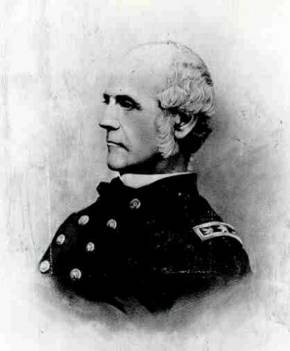 He received his early education in private schools and at Hallowell Academy. After graduation from Bowdoin College, he studied law at Northampton Law School; was admitted to the bar, and practiced his profession at Augusta and Skowhegan (then Milburn), Maine. After ten years of practice, he found law distasteful to him and entered the U.S. Navy as a purser in 1838. After several long cruises in African, European, and Pacific waters, he was called to Washington and appointed Chief of the Bureau of Provisions and Clothing. The responsible duties of this office were handled extremely well by him. Of the skill and ability which he showed in its management Senator Grimes testified in a debate in 1865; "No Bureau of this government has been more admirably and accurately managed then the Bureau of Provisions and Clothing". To this, Senator John P. Hale, added; "I think a great reason, and a very important one, is because there is at the head of that Bureau an honest, vigilant, and faithful man".
He received his early education in private schools and at Hallowell Academy. After graduation from Bowdoin College, he studied law at Northampton Law School; was admitted to the bar, and practiced his profession at Augusta and Skowhegan (then Milburn), Maine. After ten years of practice, he found law distasteful to him and entered the U.S. Navy as a purser in 1838. After several long cruises in African, European, and Pacific waters, he was called to Washington and appointed Chief of the Bureau of Provisions and Clothing. The responsible duties of this office were handled extremely well by him. Of the skill and ability which he showed in its management Senator Grimes testified in a debate in 1865; "No Bureau of this government has been more admirably and accurately managed then the Bureau of Provisions and Clothing". To this, Senator John P. Hale, added; "I think a great reason, and a very important one, is because there is at the head of that Bureau an honest, vigilant, and faithful man".
During the years Bridge headed the Bureau, many significant innovations were made. Some of the more important ones were:
-The Act of June 22, 1860, provided "That Pursers in the U.S. Navy shall hereafter be styled Paymasters".
-Advertising for competitive bids became mandatory except for personal services, and except in emergency.
-An Act of July 17, 1861, required that promotions to "Corps of Paymasters" be made from the list of assistant paymasters.
-Preserved meats, pickles, butter, cheese, and desiccated vegetables could be bought without formal advertising and sealed bids.
-A requirement written into the statutes which specified that "the Chief of the Bureau, also known as the Paymaster General, be appointed from the list of Paymasters of the Navy of not less than ten years standing". For the first time it was legally impossible for the Paymaster General to be a civilian.
-In 1862, the agitation against the rum ration became so pronounced that on September 1 of that year, it was finally eliminated and as a compensation, men’s pay was raised five cents a day. It has been said that the Act was responsible for the origin of the old Navy song: "They raised our pay five cents a day, and took away our grog forever".
According to a Navy press notice, Bridge resigned his position as Chief of the Bureau in 1869. However, shortly thereafter he accepted the position as the first Chief Inspector of Clothing, which be held until the passage of the law debarring all Navy Officers from active duty after reaching the age of sixty-two. He was detached from duty after serving afloat and ashore for fifty-five years.
Commodore Bridge was married to Charlotte Marshall of Boston when he was forty years old. They had one daughter who died at the age of five. To appease his sorrow, his friend Hawthorne wrote him: "... I trust you will be able to feel that though it is good to have a dear child on earth, it is likewise good to have one safe in heaven. She will await you there and it will seem like home to you now. Affectionately, Nath". While he seldom visited his home town, he kept the affection and respect of his townspeople to a most unusual degree. His friends there remembered him as a remarkable old man, whose clear mind and strong memory would have done credit to a man in the prime of life. He was also noted for his military bearing and elastic step. Concerning his fine character, the Kennebec Journal said: "Commodore Bridge was a man of sterling principles and rugged honesty, with a strong mind and a warm heart; a gentleman of the old school in all that means, of broad culture and with a genial polished manner.
Upon final retirement, on March 1, 1871, he went to his country home, "The Moorings", at Athens, Pennsylvania, where he spent the rest of his life. He died in March 1893.
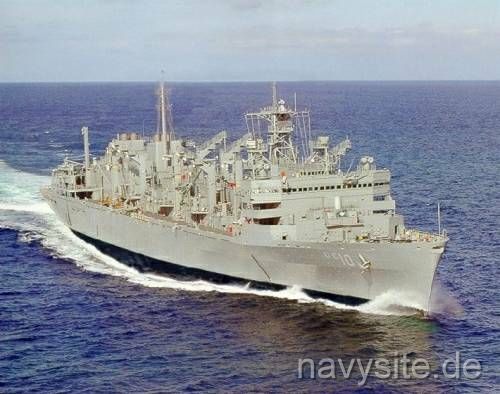
USNS BRIDGE Image Gallery:
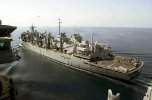 |  | 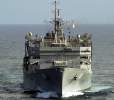 | 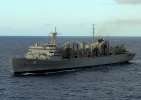 |
The photos below were taken by Ian Johnson and show the BRIDGE anchored in Gage Roads, Fremantle, Australia, on October 8, 2005. BRIDGE was assigned to the USS NIMITZ (CVN 68) Strike Group at the time.
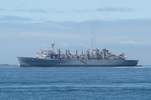 | 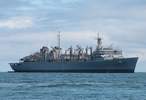 |
The photos below were taken by me and show the BRIDGE at Naval Station Pearl Harbor, Hi. The first photo was taken on March 10, 2008, the third one on March 20 off Waikiki and the others on March 22.
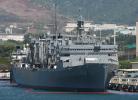 | 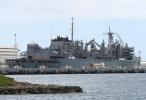 | 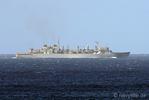 |  | 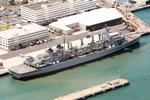 |
The photos below were taken by Michael Jenning and show the BRIDGE laid up at the Puget Sound Naval Shipyard, Bremerton, Wash., on April 17, 2016.
 | 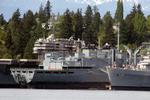 |
The photo below was taken by Michael Jenning and shows the BRIDGE laid up at the Puget Sound Naval Shipyard, Bremerton, Wash., on October 13, 2017.
 |
The photo below was taken by Sebastian Thoma and shows the BRIDGE laid up at the Puget Sound Naval Shipyard, Bremerton, Wash., on May 15, 2018.
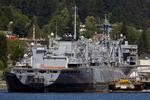 |
The photo below were taken by Michael Jenning and show the BRIDGE laid up at the Puget Sound Naval Shipyard, Bremerton, Wash., on June 12, 2022.
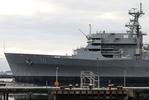 | 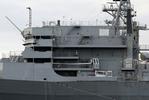 | 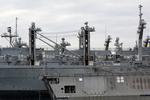 |
 Back to Fast Combat Support Ships site.
Back to Fast Combat Support Ships site.  Back to ships list.
Back to ships list.  Back to selection page.
Back to selection page.  Back to 1st page.
Back to 1st page.